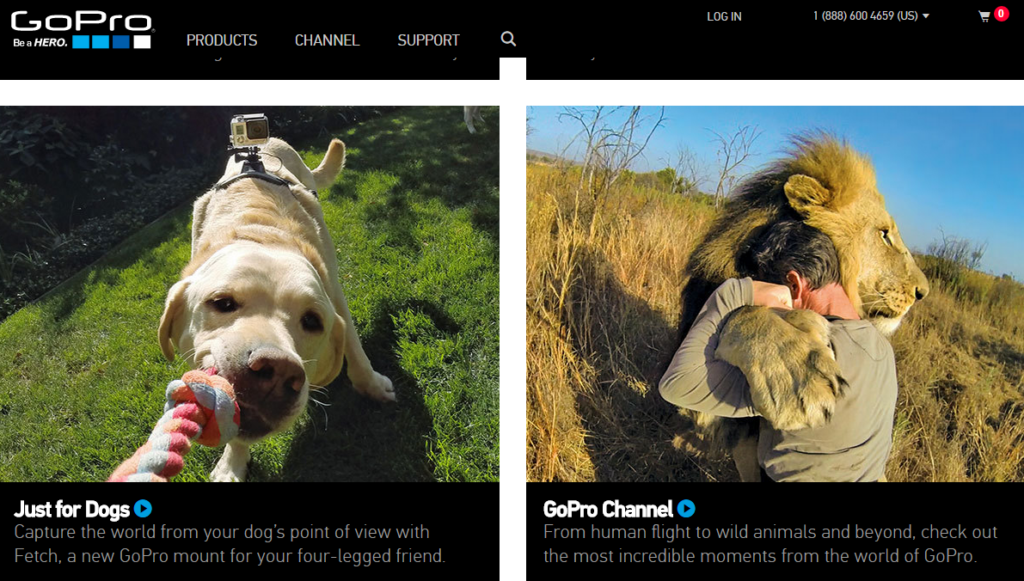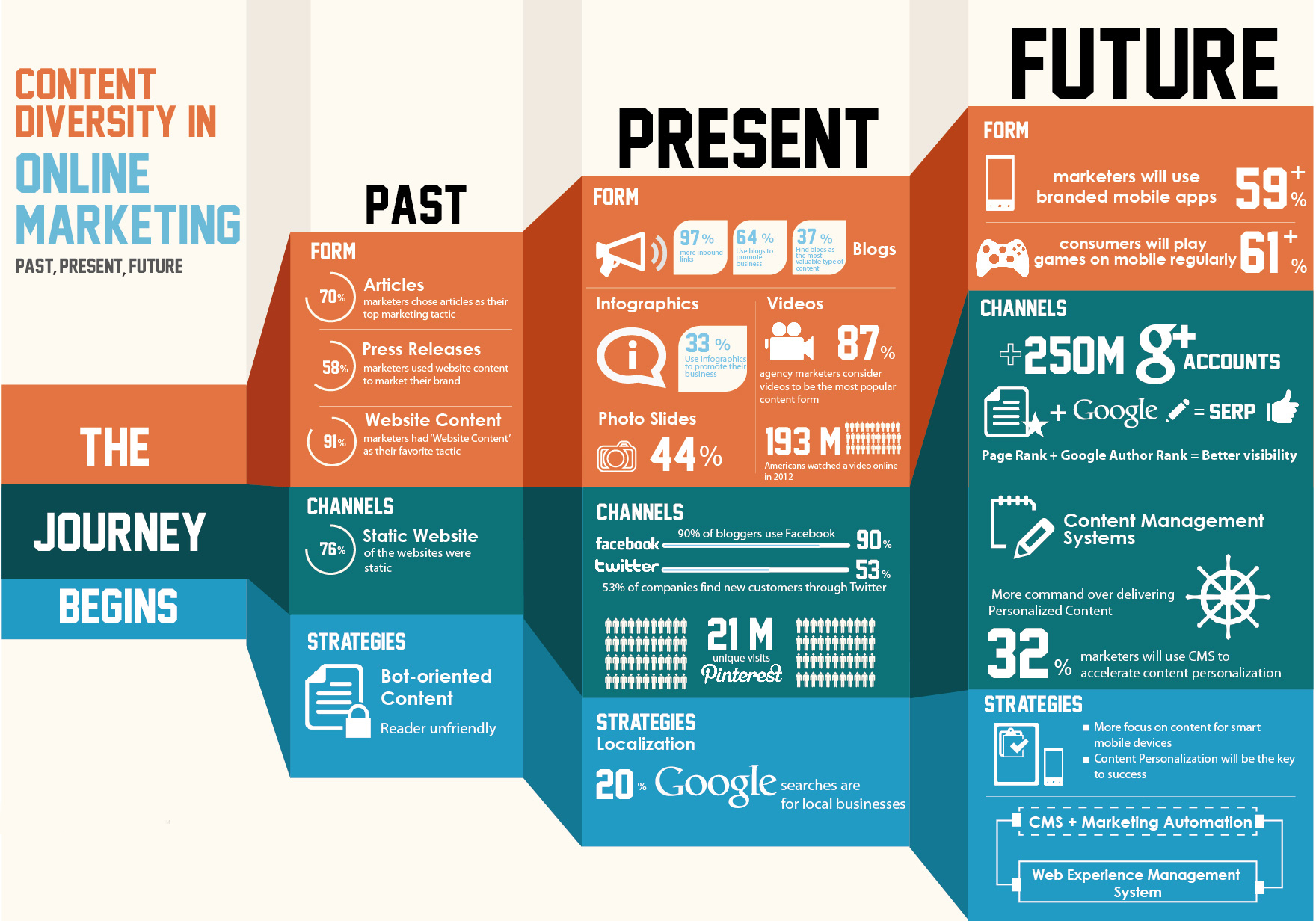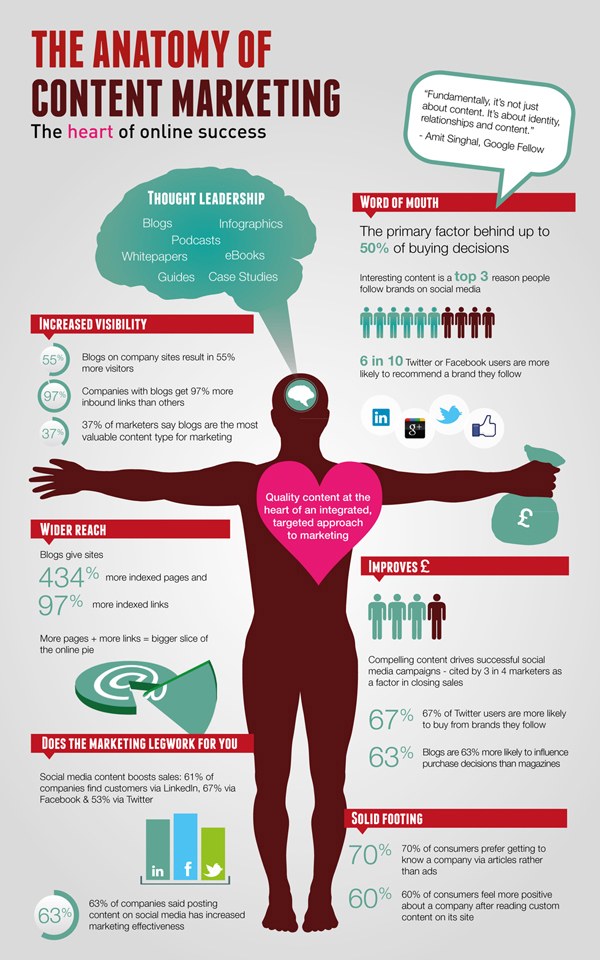Innovation in content marketing is nothing new, but sometimes it takes well-known brands and how they drive their marketing operations to recognize what’s really valuable. We’ve gathered some top content marketing examples and tips from some of the most recognizable global companies. Some aren’t only about innovation, but rather they show companies sticking to what’s most important about that brand. Others are more on the cutting edge. Here are my four top picks:
1) Pick a strategy that is core to your brand. IBM is known for three key assets: Its technical expertise, its role as long-time market leader, and its position as a respected source of IT information. To match its steady flow of content to its brand attributes IBM follows the same path. To uphold its reputation as a technology leader for more than a century, it has to produce authoritative content that underscores its thought leadership. Because the company is a technical powerhouse, it has to ensure that the content is technically authoritative. And because the company is trusted by millions to provide detailed descriptions of challenges and solutions, it has to make sure that its content is at an expert level. While trying to follow in IBM’s footsteps is not an easy task, it provides a strong lesson for how to approach your content. It should be well-written, possess authority, and have an expert voice. That’s what customers want and respond to.
2) Don’t be boring. This might sound obvious, but with many business-to-business or business-to-government solutions, it’s not always easy to sound interesting on technical topics. Resist the temptation to edit out content that might be fun and relevant, and that plays on popular topics or cultural experiences. Take Hootsuite as an example. There’s nothing very sexy about a tool that allows you to manage your social media posts. It’s mostly a dashboard with a number of useful applications tacked on. But Hootsuite rose to immense popularity by playing off a popular theme, the HBO television series “Game of Thrones.” It created a video called “Game of Social Thrones,” using graphics and music similar to the television show to demonstrate its capabilities. Each popular social platform has its own Game of Thrones city, and logos and images are cleverly used throughout. Timing is everything, of course, and the Hootsuite video garnered lots of buzz on YouTube. Hootsuite also makes sure that its content, even when serious, is fun, increasing its popular appeal. So while your brand or product may be technical and specialized, you can still write content with which your audience will identify on a popular level. The lesson: Don’t feel that you need to be serious all of the time. Create some fun, light content now and then.
3) Tell stories. It’s easy to fall back on technical explanations, and these are often important when conveying the value that a product or solution brings to the market. But telling a human interest story that illustrates what that technology brings to customers can be much more penetrating. Few do this better than Microsoft, whose “Stories” blog posts rarely even include the term software. Instead, they tell stories of how Microsoft technology has helped people, and in some cases changed their lives. In one example featuring sportscaster Daniel Jeremiah, the story is one of the human experience, of triumph, challenge and redemption. Daniel explains how as a scout for the Philadelphia Eagles, when he didn’t trust his instincts and the data at his disposal, he lost the opportunity to push for Seattle Seahawks superstar Russell Wilson. It’s a fun,personal and powerful story, and one that demonstrates Microsoft’s leadership not with a hard sell of its products, but with a tale that will stick in your mind.
4) Go visual. Visual images draw attention, tell a story, and help illustrate a brand’s true value. The problem is, many companies, particularly in the technology space, don’t believe they have much they can show using photos or high-impact graphics. I’m going to put forward GoPro as a great example of a company that relies on the visual to tell it brand story. And yes, I recognize that it’s not a fair comparison—a company that sells action-oriented video equipment of course would have great videos to show off its products. But the thing about GoPro is that it almost never actually shows its cameras in its marketing efforts. Instead, GoPro focuses on its users. One of its leading cameras is called the Hero, and its campaign is to turn its customers into heroes. Much of its content is created by passionate users who are, in turn, becoming public heroes. Companies who aren’t in the video business can take a similar approach. Tell the story of your customers and end users using video and other visual assets to make them the heroes—for the challenges they are addressing and the problems they are solving. At the very least, use visual content and images to enhance your text-based content.
Taking an innovative approach to content marketing can pay off in spades for any brand willing to think creatively and act accordingly. But sticking to some basic truths about what customers want and expect will increase your brand footprint and drive market recognition and share.
What’s more valuable to a company? A visitor to its website who spends 15 minutes scanning a wide variety of pages, or a visitor who comes and goes in three minutes? The obvious answer is the first one, because as any marketing executive can tell you, “stickiness” and time on site are drivers for the website experience. But what if the first person is taking so long because they can’t find what they are looking for and the second person came and left quickly because they readily found the white paper they wanted or even transacted? The lesson here is not that time on site isn’t the only metric you should be evaluating. In fact, using metrics to evaluate the performance of your site may not be as straightforward as it looks.
Take the recent news about Instagram over-taking Twitter in terms of volume last year. “Instagram Is Now Bigger Than Twitter” was the headline everywhere from CNBC to Re/Code to the New York Times. But how meaningful is that comparison? Twitter has some 284 million active monthly users, Instagram more than 300 million. Yet, as an article in Slate describes it, the two are different: “One is largely private, the other largely public. One focuses on photos, the other on ideas. They’re both very large, and they’re both growing.”
Another metric that is often bandied about is unique monthly visitors. This measures the number of people that come to a site and discounts repeat visitors. Again, that might sound like the ultimate metric for evaluating the attention that a site is getting. Still, it doesn’t measure what those unique visitors are doing on the site. If it is a content-driven website, like the Huffington Post or Buzzfeed, a more important measure may be “total time reading.” There, the number of visitors who come and leave quickly isn’t very valuable to advertisers who provide the revenue for content-driven sites. Total time reading is far more important, and smart advertisers recognize the difference and factor that in accordingly.
A common measure reported on widely in the media when comparing different brands’ web traffic is the number of website visitors. This is frequently sourced to web measurement and analysis companies who make these types of evaluations. But even these can be highly misleading. First and foremost, according to a recent post in medium.com, the most widely quoted source of web traffic, Comscore Networks, only counts U.S. users. If a brand is global or operates overseas like a many government defense contractors, the metrics will not include that traffic in the totals. In addition, these reports are often based on sampling which can distort the actual numbers for smaller brands with a more limited number of visitors. It’s also not yet clear whether these services are including site traffic from mobile apps, which may be a very important measurement tool for many websites as more and more visitors use mobile devices to access information on the web.
So if the three most commonly-used metrics for measuring the success of a website—time on site, unique monthly visitors, and total traffic—all have their flaws, what is the best way to evaluate how a site is doing?
The answer is there is no best answer. All three of those key metrics are useful, but they need to be taken for what they are which is a set of imprecise and blunt tools.
A better way to look at the most effective mix of metrics is to find the best blend that will help evaluate “value.” Time on site is important, but only as an element in value. In reality, for media websites, advertisers don’t actually want a customer’s time, they want to make an impression that will lead to a transaction or buying decision. On the other hand, for an enterprise site offering IT solutions where the buying cycle is long and a visit to the website may be part of the research process, time is valuable as a measurement for a customer’s information gathering step in the cycle. Where they go on the site—to resources, for example—may say a great deal about where that customer is in the cycle and how to best to pursue him or her.
Where the visitor enters the site may be a key performance indicator for both organic search results or for a lead-generation driven campaign that takes the visitor directly to the intended content. Spending time on the blog page may be an indicator that the site’s content is fresh and engaging and is bringing target audiences back for more. Reading product and solutions pages may indicate a prospect that needs to be watched to make sure they are getting what they need to make a purchasing decision.
The right answer is that value has to be a combination of a number of factors, and using multiple metrics can help understand if the site is achieving its goal of providing that value. But no marketer should get too hung up on any single measurement.
The Content Marketing Institute defines content marketing as “…a marketing technique of creating and distributing relevant and valuable content to attract, acquire, and engage a clearly defined and understood target audience – with the objective of driving profitable customer action.”
This definition is of course part and parcel to a CMO’s core objectives, which is why marketing teams are devoting a greater share of budget and resources to content marketing. In a 2014 survey of Fortune 500 CMOs conducted by The CMO Club and Spredfast, 60 percent of respondents intend to increase their content marketing budgets. Their enthusiasm is not based on a “cross our fingers and hope it works” approach; almost two-thirds (66%) of CMOs are predicting a positive return on investment (ROI) from their content marketing campaigns.
As CMOs gain confidence directing more resources and budget towards content marketing, there is very likely a team within the organization growing less sure of its footing within the content ecosystem – public relations. There is irony here, as public relations professionals no doubt read the content marketing definition and grumble to themselves (or perhaps out loud), “sorry to burst your bubble here, but we’ve been doing this content marketing thing for quite some time.”
This is true, to an extent. The efforts may not always be branded in this fashion or as inclusive of as many channels, but PR professionals have long been tasked to create and distribute high-strategy content. And therein lies the danger; that CMOs may forge ahead with content marketing and pull in the PR team as an afterthought, or not at all. This approach threatens to create counter-productive silos by leaving capable, experienced PR teams without a role that can add the most value to the organization.
Because content marketing increasingly lives in an organizational gray area, CMOs with ownership of content marketing budget, staff, and direction should consider the following to fully maximize the value of PR staff, and ultimately the content marketing program itself:
Recognize budgets are growing, but not infinite
Content marketing budgets are expanding, but unless CMOs are seeing immediate, across-the-board ROI it will be difficult to get blank checks from CXOs. Earned media is a no-cost (beyond labor time) investment that can allow content marketing efforts to continue interrupted – even during periods when budget is not allocated to “paid media” channels.
While drawing a straight line between media relations and lead generation or website visits can be difficult to see, it is there. Earned media can drive down customer acquisition costs for a content marketing campaign, as long as the right measurement tools are in place to capture the results of these earned media efforts.
Earned media remains top purchase influencer
Not only can earned media be the most cost-effective content marketing channel for CMOs, it can also be the most effective. A 2014 Nielsen in-lab study commissioned by inPowered exposed consumers to three content sources: third party news and other credible sources (earned media), branded content (owned media), and user-generated content (reviews, etc.). Not surprisingly, earned media emerged as the most effective information source at all stages of the purchase lifecycle and across all product categories. And the difference was not subtle; against branded content, earned media was found to be 80 percent more effective at the bottom-of-the-funnel or purchase consideration stage, 80 percent more effective at the middle-of-the-funnel or affinity stage, and 38 percent more effective at the top-of-the-funnel or familiarity stage.
Bottom line: content marketing initiatives are ultimately judged by sales and revenue generation, and earned media continues to prove itself as a powerful purchasing influencer.
Be cognizant of PR paranoia
The current state of media likely has your PR team fairly freaked out at this point. Print publications continue to disintegrate faster than BlackBerry’s market share, and chasing the social media payoff pot of gold is a tedious exercise. If the CMO shuts PR out of content marketing strategy and execution, or brings the team in so late that it is relegated to a tactical role, significant PR brainpower is going to be left rotting on the sidelines. Identify areas where public relations – whether it is an internal team or external agency – can add the most value, and then provide them with the mandate and resources to execute in those areas.
All content writers are not created equal
Marketing teams excel at developing content designed to sell – whether it is through collateral that provides air cover for the sales team, website and landing page content that can convert leads, advertising copy, etc. Editorial content opportunities however, tilt increasingly towards sponsored content, advertorials, and even earned thought leadership content that requires a much softer sell. In fact, much of the time this type of copy cannot reference the company’s product/service or be in any way self-promotional.
PR teams understand how to walk the tightrope of creating and placing content that communicates core messages without reading like overt marketing copy, and CMOs should leverage this expertise.
Don’t let content volume kill content marketing
Ending up with too much of a good thing is problematic enough – the gourmet cupcake craze is Exhibit A of that fact. Too much of a bad thing is even worse, and therein lies the danger for content marketing operations that spew out page after page of useless content. PR teams are a proven source of valuable content, understanding that low-quality articles cannot be placed in reputable, high impact articles.
$135 billion will be spent on new digital marketing collateral (content) in 2014, and automation tools will spike this volume even further. In this scenario, quality content becomes the great unequalizer for CMOs to differentiate their products, services and brand.
Are you planning to integrate or upgrade your content marketing into your online marketing strategy? Not sure where to begin? Here is a basic rundown of how to create an effective content marketing strategy.
1. Establish Your Conceptual Target
An effective content marketing strategy must begin with this first critical step. The goal is typically pursuing new customer opportunities while preserving your core customer base. Understanding who they are, where their interests lie and how to get them to take action and engage with your brand is key to developing your content strategy.
2. Don’t be a One Hit Wonder
As opposed to advertising – which is driven by “The Big Idea” – to stay fresh and engaging, your content marketing strategy needs to offer a variety of premium content on a number of contextually relevant topics When content marketing teams are under resourced, they tend to gravitate back to the big idea and get boxed into a an approach that’s not scalable long term.
3. Use an Editorial Approach
Too many content marketing programs fail in the planning phases of the program because the a long term content strategy has not been fully thought out – so the content being developed using a shoot from the hip approach tends to be more episodic than strategic. The most effective way to avoid failure is to identify specific themes for your content strategy that align with the cyclical business or personal needs of your target audience
4. Be Contextually Relevant
The content you develop must be interesting, engaging and above all else, relevant. Your conceptual target should be able to quickly connect the dots between his challenges and the capabilities you can offer to overcome them – the more contextually relevant your content is to them the easier they will be able to make that connection
5. Process Driven Approach
Since content marketing is still a relatively new approach, a lot of companies are not investing adequate resources or the defined process that planning, managing and publishing an adequate amount content requires. Building a solid content marketing workflow process, and investing in the necessary resources to implement it – whether internal or external – are critical to your success.
6. Collaboration is Key
As with any emerging marketing channel – and social media is a good example of this -there is an internal struggle over which department actually “owns” it. Until that’s figured out, many companies will make it a shared responsibility between their PR, Advertising and Creative departments – passing the content baton from one silo to the next with no clear strategy. If you must borrow the resources, make sure there is a coordinated effort to collaborate as a team on the themes, goals and structure of your content marketing program.
7. Cadence and Consistency
When creating your content strategy, be sure to decide on the frequency of your content marketing so that once your audience is engaged, they stay engaged. Having a consistent and predictable flow of content that your customer can rely on is critical to establishing brand credibility.
8. Use the Right Channels
Instead of hoping your audience stumbles upon you, be sure to publish your content where they already are – in their own environment where they will be more willing to engage. Consider promoting your content on broader social sites like Twitter can make it go viral. If the content is what readers are looking for, they won’t hesitate to share – and that’s the holy grail of content marketing.
9. Leverage SEO
A solid content marketing strategy geared toward the right audience is worthless if it doesn’t reach that audience one way or the other. One of the most effective ways to leverage that content is to employ a strong SEO strategy to incorporate keywords that your customers are using to search for the solutions you are ultimately trying to sell to them




